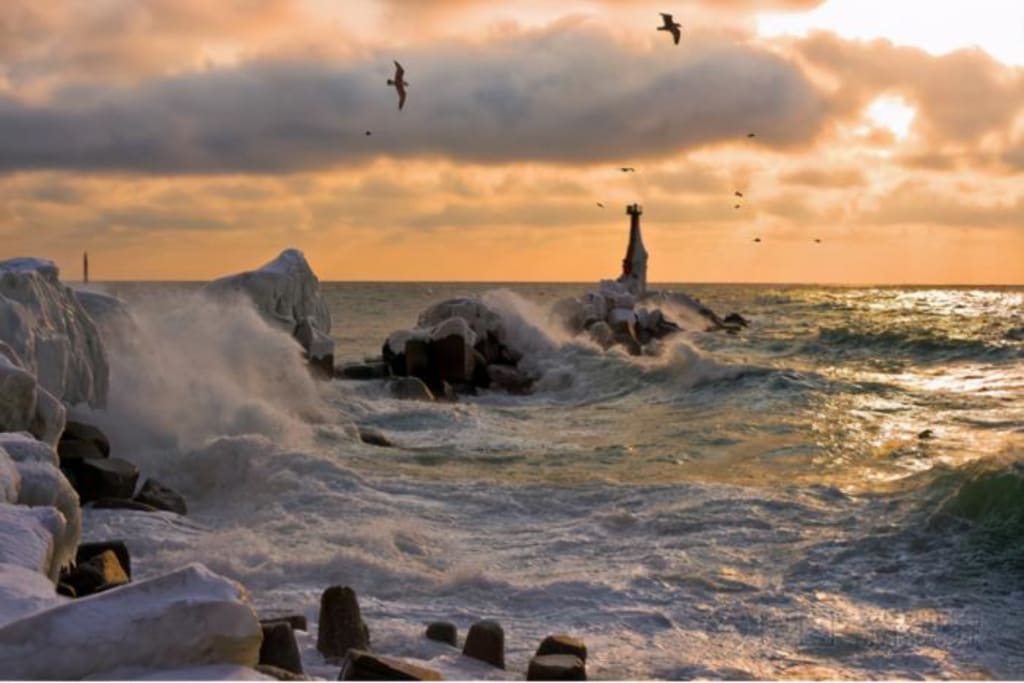
According to historical records, the Earth has experienced five mass extinction events. The first mass extinction occurred about 440 million years ago, and fossil studies show that a small celestial body about 10 kilometers in diameter triggered the disaster. The collision produced a huge amount of dust and smoke, and a large amount of material that was difficult to disperse gathered over the Earth, resulting in a significant reduction in the amount of light received by the Earth, which led to an ice age.
Faced with the unfamiliar ice age, many invertebrates panicked, as they had never experienced such a life before. Despite their efforts to survive in the harsh environment, they eventually had difficulty adapting to the prevailing conditions, and both the phylum Chloropoda and the phylum Archaeopteryx were lost in the disaster.
The time came to the Late Devonian, and the creatures on Earth ushered in the second great test of survival, this time mainly for aquatic organisms, especially invertebrates in the ocean. At that time, the oxygen level in shallow water dropped extremely fast, and the situation for invertebrates such as brachiopods and chrysoprase was extremely difficult.
The third biological extinction occurred between the Permian and Triassic periods, and this catastrophe led to a reduction of more than half of the number of biological families and at least 90% of the number of species. The fourth extinction occurred between the Triassic and Jurassic periods when all dentate species became extinct. The fifth extinction is perhaps more familiar, because of the restless little star, the Earth's former overlord dinosaurs had to give up the throne so that humans have "opportunity to take advantage of".
Nature's success and failure
There is an idiom called "Success is also Xiao He, defeat is also Xiao He", this idiom is from "Historical Records - Huai Yin Hou Lie Zhuan", and is a high summary of Han Xin, the founding minister of the Western Han Dynasty, a few words, said all his life. Han Xin's success came from Xiao He's recommendation, and it was Xiao He who caused Han Xin to lose his life. Therefore, there is a saying in history that "Xiao He was also successful, and Xiao He was also defeated".
The dinosaur's experience is somewhat similar to that of the historical general Han Xin. It was nature that made the dinosaur a success, it was nature that made him stand out and have the chance to become the hegemon of the earth, and it was nature that finally made him perish and forced him to abdicate.
Why do we say that nature made the dinosaurs?
Most people know the story of the extinction of the dinosaurs, which took place in the Cretaceous period, about 65 million years ago, when the Earth witnessed the fifth mass extinction event, in which the dinosaurs died. The cause of the mass extinction, there are several theories such as meteorite impact, continental drift, and climate change, but there is no definite conclusion.
Compared with the tragic experience of the late dinosaurs, there are probably only a few people who understand the history of dinosaur growth. About 234 million years ago, the Earth was in the Carney period, when a small-scale biological extinction event occurred. The culprit of this extinction event was the heavy rain that continued to fall for 2 million years.
The creatures living at that time spent their whole lives without seeing the rain stop. This event is also known as the "Carney Period Flood Event". It is through this continuous heavy rain, that the Earth's environment has undergone a radical change, the Earth's original biological chain reorganization and reshuffled, and the dinosaurs took the opportunity to rise.
How can a heavy rainfall for 2 million years?
Compared to the serious consequences of this heavy rain, we may be more concerned about why the Earth will usher in this inter-century rain, it has been raining for 2 centuries, which is unimaginable.
According to the data, during the Permian-Triassic period, the Earth's continents were not as separated as they are today; they were connected and linked into one large area at that time. Such a structure is conducive to maintaining the stability of the continents, but there are certain disadvantages, such as the ocean moisture can not penetrate the interior of the continents, only in the adjacent border areas constantly hovering, which led to the interior of the continents is extremely dry, geologists found the red sand and gravel can well prove this point.
The long-standing water-drought imbalance has set the stage for a crisis that is being nurtured by this trans-century rain. Not coincidentally, problems have also arisen in the region known as "Langria," where volcanoes have been erupting for more than 500 years, emitting untold amounts of carbon dioxide and raising the Earth's temperature by as much as 7 degrees Celsius in some areas.
Driven by the volcanoes, the distribution of water vapor on Earth became more uneven, and heavy rain finally fell on the planet. At first, creatures living in arid areas had a feeling of "rain after a long drought", and the green grass grew in the once desert areas. However, with time, some of the plants with underdeveloped root systems suffered, they could not resist the wash of heavy rain, after some desperate resistance, they finally reluctantly let go of the hand of Mother Earth.
The plants with relatively well-developed roots also felt the same pressure, they continue to secrete resin in order not to be carried away by the rain, as evidenced by the amber fossils of the Carnian period found by geologists in many places.
What did the Earth look like when the rain stopped?
After a long wait, the volcanoes of Langria finally slowly calmed down, the magma inside finally stopped churning to meet the Earth, the howling sky finally stopped crying, and parts of the Earth are slowly returning to their original arid appearance.
Although the Earth's environment is slowly recovering, the Earth's biological chain can no longer recover its original appearance, many animals have been in the duration of the 2 million years of heavy rain disappeared, and many can not adapt to the environment of the plant also disappeared.
It is worth mentioning that this heavy rain gave the original survival disadvantage of the dinosaur family and brought a huge opportunity for development. The study found that before the Carney period flooding event, the number of dinosaurs accounted for about 5% of the total number of terrestrial vertebrates, while after the occurrence of the Carney period flooding event, the number of dinosaurs accounted for 90%, this data is combined with the analysis of the fossil situation of dinosaurs.
Why did the harsh natural environment make the dinosaurs?
First of all, plants are in the basic position of the biological chain, which shows that the survival and development of animals and plants are inseparably related. After the heavy rains, the earth's grasslands were greatly reduced, and animals previously accustomed to nibbling on the surface of small grasses faced a serious food crisis. The tall trees, because of their more developed roots, resisted a test, and most of them survived, which just gave the dinosaurs who could eat the leaves high up in the trees a rich food.
Secondly, at that time, the ferns gradually decreased, replaced by gymnosperms, which are rich in fiber, many herbivores that can not digest this material also faced a great danger of extinction. Unlike dinosaurs, which had narrow intestines, they were able to digest the fibrous material in gymnosperms very well.
Finally, the continents were contiguous at the time, and the dinosaur family began to rapidly expand their territories after they flourished, with dinosaurs appearing in many parts of the continent, which laid a solid foundation for their future dominance.
About the Creator
Bar wall
Countries people need science, not scientific development, will certainly become a colony。






Comments
There are no comments for this story
Be the first to respond and start the conversation.